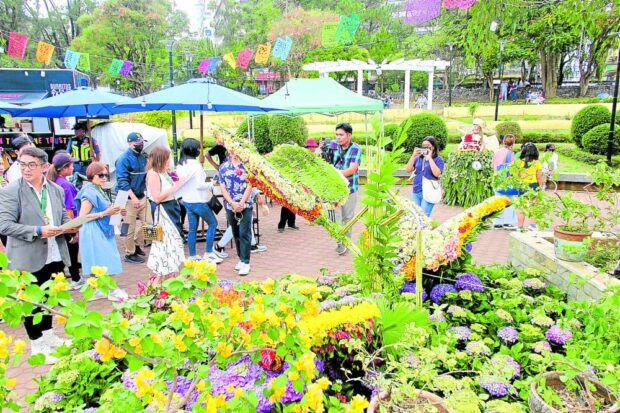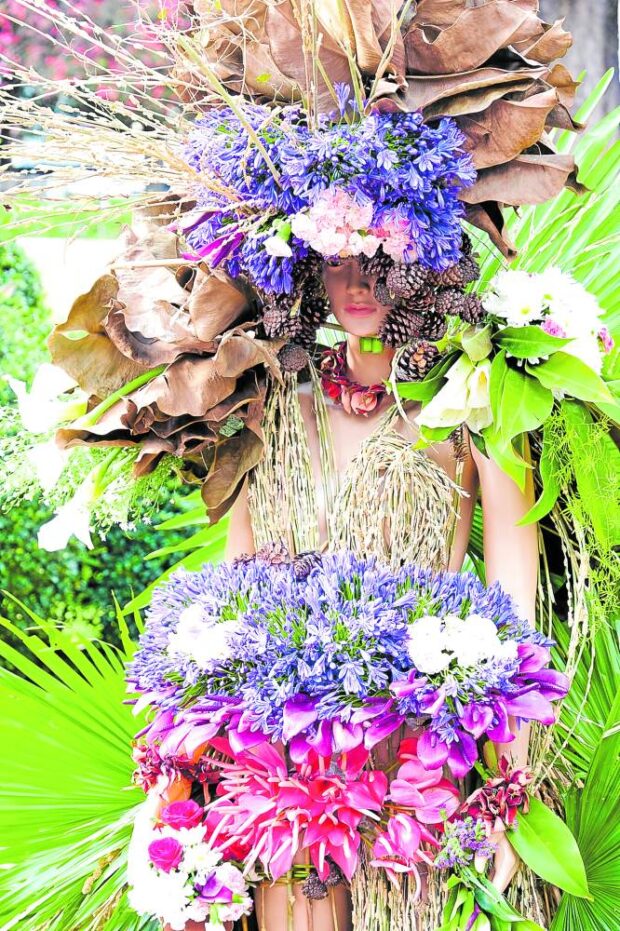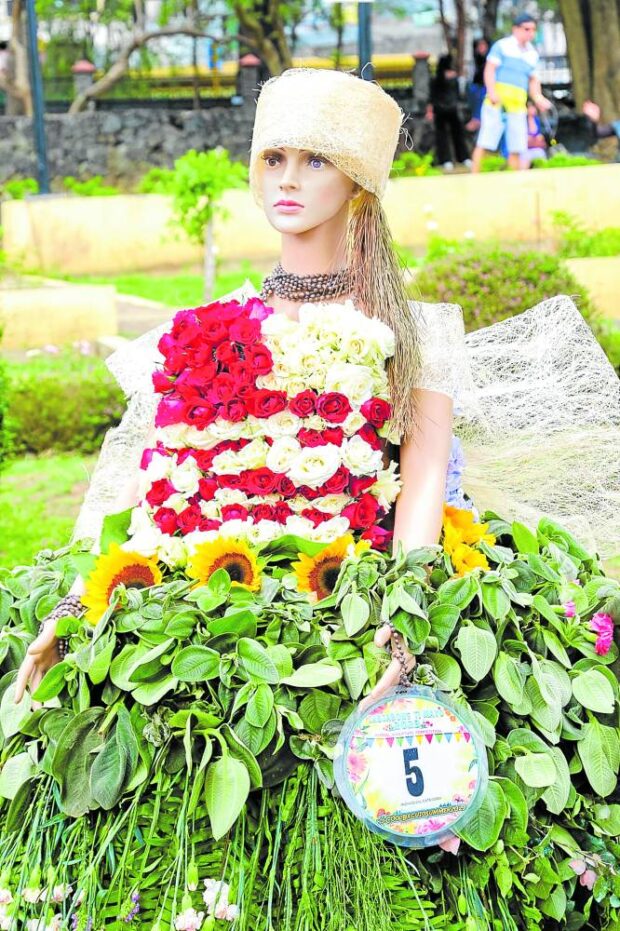Unique ‘Flores de Mayo’ blossoms in Baguio

FLORAL COUTURE | Many provinces, towns, and cities around the Philippines associate the month of May with fiestas and the traditional “Flores de Mayo” (Flowers of May) processions, one of the highly anticipated community events that give townsfolk a reason to gather and celebrate. In Baguio, the “Sabsabong ti Mayo” is the city’s version of this event, featuring a unique exhibition combining fashion and an assortment of colorful flowers at Burnham Park’s Rose Garden. (Photo by NEIL CLARK ONGCHANGCO)
BAGUIO CITY, Benguet, Philippines — Since the start of May, visitors have made it a point to tour Burnham Park’s Rose Garden, where mannequins wrapped in gowns made of colorful blossoms have been attracting crowds.
One mannequin has a blouse made of purple flowers, trimmed with daisies, that also rolls around its thighs like a wraparound skirt. It is topped with a huge purple sun hat adorned with a large sunflower.
A mother and her daughter sat last week between two mannequins, one covered with tulips and carnations, while the other wore a bustier made of anthuriums and a skirt made of ferns.
These garland-wrapped mannequins have made the Rose Garden the latest “selfie” destination for the summer capital’s repeat tourists, who journey back to Baguio every weekend for the relatively colder weather this summer.
The flower couture is exhibited each year during the annual “Sabsabong ti Mayo” (Ilocano for Flowers of May). These flower outfits were first displayed in 2021 to cheer up residents who were finally allowed to leave their homes because of strict travel restrictions at the height of the COVID-19 pandemic.
Article continues after this advertisement
(Photo by NEIL CLARK ONGCHANGCO)
‘Spiritual rebirth’
This year, this modified “Flores de Mayo” included flower art pieces, like a giant green butterfly put up by Camp John Hay Leisure Inc. at the center of the garden.
Article continues after this advertisementIn a framed message, the company describes its creation as a metaphor for “spiritual rebirth, transformation, change, hope, and life,” and asserts that the butterfly “teaches us that small things matter and we are all connected to a bigger system.”
That appears to be the same principle that drives the Baguio Tourism Office to expand its summer programs in order to sustain the momentum of the city’s economic recovery.
Last year, the Cordillera was visited by 1.284 million domestic and foreign tourists, most of whom passed through or stayed in Baguio, according to Sylvia Chinayog, Cordillera operations officer of the Department of Tourism (DOT).
The numbers have yet to match the 2.185 million tourists who visited the city and the provinces of Benguet, Ifugao, Kalinga, Abra, Apayao and Mountain Province in 2018 or the two million guests in 2019 before the global pandemic broke out.
But Baguio hosted the bulk of the Cordillera’s visitors in 2022, rebounding with 1.042 million tourists last year from a slump of 268,912 guests in 2020, when the pandemic began, and 267,480 in 2021, according to a DOT chart.
Chinayog said robust tourism “is associated with the opening of borders nationwide and the ease of travel restrictions.”

(Photo by NEIL CLARK ONGCHANGCO)
Tourist arrivals
“In the landscape of regional tourism, 99 percent [1,275,174 tourists] are domestic,” she added, with only 9,169 foreigners visiting the Cordillera last year.
The 2022 tourism expenditure report concludes that each foreign guest spent P7,392 for each day of a visit last year, for a total of P67.7 million throughout 2022. Each domestic tourist spent P4,035 a day, or a total of P5.148 billion last year.
Revenge tourism has benefited Ifugao, home to the centuries-old rice terraces, which were visited by 19,191 people in 2022, up from 10,047 in 2020 and 2,514 in 2021.
Benguet province, which grows the salad vegetables supplied to Metro Manila and other parts of Luzon, has drawn 14,465 tourists in 2022, which was far higher than the 5,677 visitors in 2020 and the 2,587 guests in 2021.
Benguet also grows the flowers sold in Baguio, a commodity that has become part of Baguio’s tourism brand. Because of the pandemic lockdowns and quarantines that lasted for more than two years, many business owners in Baguio almost closed shop, suffering zero revenues because travel was prohibited.
Before the pandemic, residents and tourists “end up making that ‘impulse buy’ when they see a flower they love,” said 66-year-old vendor Cristina Tabano, who has been selling flowers for more than 30 years.
“Flowers make people’s lives better. They buy flowers for their home altars. They buy flowers for their wives. A customer once said she would rather go hungry so she can buy a stem [of rose] because the blossoms were good for the soul,” she said.